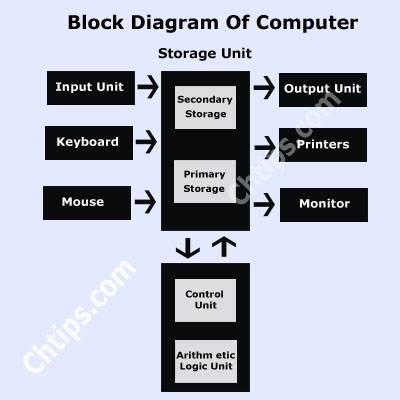What is the Full Form of ALU : Arithmetic and Logic UnitALU stands for Arithmetic Logic Unit, and it is a part of the central processing unit (CPU) that performs arithmetic and logical operations with incredible speed and almost 100% accuracy.
It is also known as the Integral Unit (IU) which is an integrated circuit of the central processing unit (CPU) and graphical processing unit (GPU).
ALU can execute logical and arithmetical operations such as addition, subtraction, multiplication, division, and logical operations like OR, AND, >, <, =, ==, with high speed and with great precision.
It can also perform mathematical and bitwise operations.
ALU is further categorized and divided into two main parts that are arithmetic unit (AU) and logic unit (LU). The memory stores the program instructions and data into the CPU.
| A | Arithmetic |
| L | Logic |
| U | Unit |
In this article we are going to learn and discuss on What is the Full Form of ALU in Computer | ALU Full Form.
Let us dig in the topic in more detail.
Full Form of ALU | ALU Stands For

What is the ALU in Computer?
The computer consists of an Arithmetic Logic Unit (ALU), which performs addition, subtraction, multiplication, division and these are arithmetic operations, a logical operation such as AND and OR tell us the value is more significant, smaller or equal to, and gain access to the result of the processing operation on the computer.
Modern CPUs need very powerful, and complex ALUs, modern computer contains control unit.
The control unit collects the data given by the arithmetic logic unit and carries out that instruction to that data.
What is ALU with Diagram?
An Arithmetic Logic Unit (ALU) is a digital circuitry that is used to perform arithmetical and logical operations.
It represents the fundamental building block of the central processing unit (CPU) of a computer.
The majority of CPUs and processors contain one or more ALUs which are used for more complex operations.

In addition of more ALUs in modern CPUs include Control unit (CU).
Most of the operations of CPUs are performed by one or more ALUs, which load data from registers. A register is a small amount of storage available as a part of a CPU.
The control unit sends a signal to ALUs to let know what operation to perform on those particular data, and also ALU stores the result in the output registers.
The control unit (CU) moves the data between these registers, the ALU, and the memory.
What is the ALU used for?
As I mentioned above, ALU is used for certain arithmetic operators like addition, subtraction, multiplication, and division, and in logical operators are a comparison of values such as NOT, AND, OR.
The information in a computer is stored in the form of binary numbers, i.e., 0 and 1. Transistors are used to operate binary numbers in this number.
There are two possible states of a switch, which are open and closed.
In an open transistor, if there is no current, it represents a 0. In a closed transistor, if there is a flow of current, then it represents 1.
Operations can be accomplished by connecting multiple transistors. One transistor can be used to control a second one.
Whether a transistor is turned on or off depends on the state of the second transistor that the transistor responds to. This arrangement is called a gate because it can allow or stop current. The easiest operation is the NOT gate.
This type of operation uses a single transistor. It uses a single input and produces a single output. This is always the opposite of information.
The other gate consists of multiple transistors and uses two inputs. If the first or second input is 1, the OR gate returns 1.
The OR gate returns 0 only if both inputs are 0.
AND gates return 1 only if both the first and second inputs are 1.
An XOR gate, also known as an X-OR gate, returns 0 if both inputs are 0 or 1, otherwise the result is 1.
Related Articles
- Full Form of Virus
- Full Form of PDF in Computer
- Full Form of HREF in Computer
- Full Form of HDMI in Computer
- Full Form of PAN in Computer
- Full Form of OMR in Computer
- Full Form of CU in Computer
- Full Form of DSL in Computer
- Full Form of TFT in Computer
- Full Form of NAS in Computer
- Full Form of SSD in Computer
- Full Form of VLSI in Computer
- Full Form of SMPS in Computer System
- Full Form of CRT Monitor in Computer
- Full Form of USB in Computer
- What is the Full Form of GIGO
- What is the Full Form of SCSI
- Computer Basic Tutorials
Functions of ALU in Computer Systems
The ALU performs arithmetic operations such as addition, subtraction, multiplication, division, and logical operations such as OR and AND.
Memory stores program instruction data. The control unit retrieves data, instructions, and data from memory.
It uses ALU operations to execute instructions using data, and the control unit and ALU are called central processing units (CPUs).
When an I / O command occurs, the control unit transfers data between the memory and the I / O controller.
Characteristics of ALU in Computer
The ALU has the circuits that are added, subtracted, and multiplied, the two arithmetic values with absolute perfect accuracy, as well as the logical operations such as AND or OR where 1 is taken as true, and 0 is taken as false so for example, in AND if 1 is input and 0 is output, so the result is 0.
The ALU has over 100 registers that contain the results of additional arithmetic operations or temporary results to the main memory.
Difference Between ALU and CU
Arithmetic logic units (ALUs) are part of the processor that performs arithmetic operations, comparison operations, and other operations.
A control unit is a component of a processor that transmits and coordinates most of the functions of a computer.
The ALU represents the basic component of a computer’s central processing unit (CPU). The control unit moves data between these registers, ALUs, and memory.
The ALU consists of three types of functional parts: storage registers, operation logic, and sequential logic.
There are two types of a control unit: a Hardwired control unit and a Micro programmable control unit.
What are the Components of ALU
ALU consists of three types they are.Storage registers: The W register is the fundamental component of ALU as it is used in most arithmetic or logic instructors.
The W register is shown as an output of ALU and forms a feedback loop into ALU.
The operation logic contains all operations that influence Boolean values. The Boolean value can be true or false. The basic operators are AND, OR, and NOT.
Sequence logic is the type of logic whose output depends not only on the current value of the input signal, but also on the order of the previous inputs.
Sequential logic is used to build end-state machines, which are the basic building blocks of all digital circuits.
What is ALU in RAM?
ALU has arithmetic and logical operations. It gives the high-speed circuit output in the central processing unit (CPU) that calculates and compares the numbers transferred from RAM in the ALU for calculations, and results are sent back to RAM.
Alphanumeric data is sent from the RAM to the ALU to compare the number of results.
ALU has so-called main memory (random access memory or RAM for personal computers) and direct input or output access to processor controllers stored in input or output devices.
Incoming and outgoing flow along the electronic path.
This is called Bus in computer.
What are the 3 Components of ALU?
An ALU consists of three types of components are given below:- Storage registers
- Operations logic
- Sequence logic
Get In Touch
I have also written and compiled some articles on computers and telecommunications please go through them.
I hope you will like reading it.
I hope that all the questions and queries related to What is the Full Form of ALU in Computer | ALU Full Form have been answered here.Please feel free to contact me and if you need to add, remove or update anything from the article please let me know in the comment section or via email.
I will be more than happy to update the article. I am always ready to correct myself.
Share this article with your friends and colleagues this motivates me to write more on the related topics.
!!! Thank You !!!
